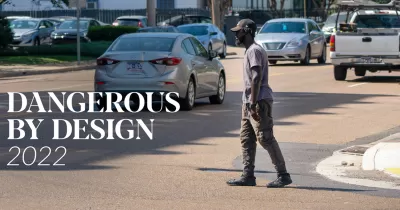The report ranks the most dangerous states and metro areas for pedestrians, who died at higher rates during the pandemic despite reduced driving.

The Dangerous By Design 2022 report from Smart Growth America highlights the “preventable epidemic of people struck and killed by walking,” ranking the most dangerous U.S. states and metro areas for traffic deaths between 2016 and 2020.
According to a press release announcing the report, “While the COVID-19 pandemic upended many aspects of daily life, including how people get around, one terrible, long-term trend was unchanged: states and metro areas are getting more dangerous for pedestrians almost across the board.”
In 2020, over 6,500 pedestrians were struck and killed by vehicles, a 4.5 percent increase from 2019, despite a decrease in driving. “With data on walking patterns from StreetLight, and special inserts from NACTO, Strong Towns, America Walks, and the Fines and Fees Justice Center, this year’s report examines where and why streets are dangerous—and what needs to be done to reverse the accelerating trend.”
Low-income communities are significantly less likely to have access to parks and other opportunities for safe recreational walking and are less likely to have sidewalks, marked crosswalks, and street design to support safer, slower speeds. Lower-income neighborhoods are also much more likely to contain major arterial roads built for high speeds and higher traffic volumes at intersections, exacerbating dangerous conditions for people walking.
The report notes that “Older adults and people walking in low-income neighborhoods were also struck and killed at much higher rates than other populations in 2020, as with past years.” While disparities in traffic deaths are nothing new, “the pandemic perpetuated existing disparities in who is being killed at the highest rates: Black and Native Americans.”
Read the full report here.
FULL STORY: Dangerous by Design 2022

Alabama: Trump Terminates Settlements for Black Communities Harmed By Raw Sewage
Trump deemed the landmark civil rights agreement “illegal DEI and environmental justice policy.”

Planetizen Federal Action Tracker
A weekly monitor of how Trump’s orders and actions are impacting planners and planning in America.

The 120 Year Old Tiny Home Villages That Sheltered San Francisco’s Earthquake Refugees
More than a century ago, San Francisco mobilized to house thousands of residents displaced by the 1906 earthquake. Could their strategy offer a model for the present?

In Both Crashes and Crime, Public Transportation is Far Safer than Driving
Contrary to popular assumptions, public transportation has far lower crash and crime rates than automobile travel. For safer communities, improve and encourage transit travel.

Report: Zoning Reforms Should Complement Nashville’s Ambitious Transit Plan
Without reform, restrictive zoning codes will limit the impact of the city’s planned transit expansion and could exclude some of the residents who depend on transit the most.

Judge Orders Release of Frozen IRA, IIJA Funding
The decision is a victory for environmental groups who charged that freezing funds for critical infrastructure and disaster response programs caused “real and irreparable harm” to communities.
Urban Design for Planners 1: Software Tools
This six-course series explores essential urban design concepts using open source software and equips planners with the tools they need to participate fully in the urban design process.
Planning for Universal Design
Learn the tools for implementing Universal Design in planning regulations.
Clanton & Associates, Inc.
Jessamine County Fiscal Court
Institute for Housing and Urban Development Studies (IHS)
City of Grandview
Harvard GSD Executive Education
Toledo-Lucas County Plan Commissions
Salt Lake City
NYU Wagner Graduate School of Public Service





























